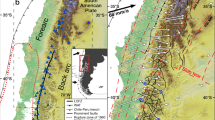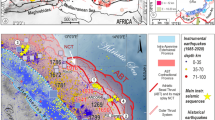Abstract
Geodetic measurements in actively deforming areas of the continents reveal the pattern of deformation in the lithosphere. If the dominant forces acting on crustal blocks are tractions at their bases, then the long-term motion of each block will be given by the average velocity of the underlying lithosphere. Slip rates between blocks estimated in this way from recent geodetic measurements across fault zones in the South Island of New Zealand and Southern California are in good agreement with slip rates estimated geologically.
This is a preview of subscription content, access via your institution
Access options
Subscribe to this journal
Receive 51 print issues and online access
$199.00 per year
only $3.90 per issue
Buy this article
- Purchase on Springer Link
- Instant access to full article PDF
Prices may be subject to local taxes which are calculated during checkout




Similar content being viewed by others
References
Brace, W. & Kohlstedt, D. Limits on lithostatic stress imposed by laboratory experiments. J. Geophys. Res. 85, 6248–6252 (1980).
Molnar, P. in Fault Mechanics and the Transport Properties of Rocks: a Festschrift in Honor of W. F. Brace(eds Evans, B. & Wong, T.-F.) 435–460 (Academic, London, (1991)).
Chen, W. & Molnar, P. Focal depths of intercontinental and interplate earthquakes and their implications for the thermal and mechanical properties of the lithosphere. J. Geophys. Res. 88, 4183–4214 (1983).
Jackson, J. & White, N. Normal faulting in the upper continental crust: observations from regions of active extension. J. Struct. Geol. 11, 15–36 (1989).
Savage, J. & Burford, R. Accumulation of tectonic strain in California. Bull. Seismol. Soc. Am. 60, 1877–1896 (1970).
Thatcher, W. Systematic inversion of geodetic data in central California. J. Geophys. Res. 84, 2283–2295 (1979).
Thatcher, W. Nonlinear strain buildup and the earthquake cycle on the San Andreas fault. J. Geophys. Res. 88, 5893–5902 (1983).
Prescott, W. H. & Nur, A. The accommodation of relative motion at depth on the San Andreas fault system in California. J. Geophys. Res. 86, 999–1004 (1981).
McKenzie, D. & Jackson, J. The relationship between strain rates, crustal thickening, palaeomagnetism, finite strain and fault movements within a deforming zone. Earth Planet. Sci. Lett. 65, 182–202 (1983).
Houseman, G. & England, P. Finite strain calculations of continental deformation. 1 Method and general results for convergent zones. J. Geophys. Res. 91, 3651–3663 (1986).
England, P. & Molnar, P. Inferences of deviatoric stress in actively deforming belts from simple physical models. Phil. Trans. R. Soc. Lond. 337, 151–164 (1991).
Lamb, S. Behaviour of the brittle crust in wide plate boundary zones. J. Geophys. Res. 99, 4457–4483 (1994).
Lachenbruch, A. & Sass, J. Heat flow from Cajon Pass, fault strength, and tectonic implications. J. Geophys. Res. 97, 4995–5015 (1993).
Bevin, A. Misc. Series 5, 87–96 ((1981)).
Bourne, S. et al. Crustal deformation of the Marlborough Fault Zone in the South Island of New Zealand: Geodetic constraints over the interval 1982–1994. J. Geophys. Res.(in the press).
Prescott, W., Savage, J. & Kinoshita, W. Strain accumulation rates in the Western United States between 1970 and 1978. J. Geophys. Res. 84, 5423–5435 (1979).
Savage, J., Prescott, W., Lisowski, M. & King, N. Deformation across the Salton Trough, California, 1973–77. J. Geophys. Res. 84, 3069–3079 (1979).
Savage, J., Prescott, W. & Gu, G. Strain accumulation in southern California, 1973–1984. J. Geophys. Res. 91, 7455–7473 (1986).
Lisowski, M., Savage, J. & Prescott, W. The velocity field along the San Andreas fault in central and southern California. J. Geophys. Res. 96, 8369–8389 (1991).
Larsen, S. & Reilinger, R. Global Positioning System measurements of strain accumulation across the Imperial Valley, California: 1986–1989. J. Geophys. Res. 97, 8865–8876 (1992).
Dong, D. The Horizontal Velocity Field in Southern California from a Combination of Terrestrial and Space-geodetic data.Thesis, Massachusetts Inst. Technol.((1993)).
Feigl, K. et al. Space geodetic measurement of crustal deformation in central and southern California, 1984–1992. J. Geophys. Res. 98, 21677–21712 (1993).
Shen, Z.-k. et al. Horizontal Crustal Deformation Velocity Map Version 1(Crustal Deformation Working Group, Southern California Earthquake Center); available at http://minotaur.ess.ucla.edu/velmap/welcome.shtml
Shen, Z. et al. Crustal deformation measured in Southern California. Eos 78, 477 (1997).
Scholz, C. The Mechanics of Earthquakes and Faulting 1st edn(Cambridge Univ. Press, (1990)).
Ellsworth, W. in The San Andreas Fault System, California(ed. Wallace, R.) 153–185 (Prof. Pap. 1515, US Geol. Surv., Washington DC, (1990)).
McKay, A. in Reports of Geological Explorations during 1888–1889 Vol. 20, 1–16 (NZ Geol. Surv., Wellington, (1890)).
Cowan, H. The North Canterbury earthquake of September 1, 1888. J. R. Soc. NZ 21, 1–12 (1991).
Eiby, G. An annotated list of New Zealand earthquakes, 1460–1965. NZ J. Geol. Geophys. 11, 630–647 (1967).
Anderson, H., Webb, T. & Jackson, J. Focal mechanisms of large earthquakes in the South Island of New Zealand: implications for the accommodation of Pacific–Australia plate motion. Geophys. J. Int. 115, 1032–1054 (1993).
Working Group on California Earthquake Probabilities Probabilities of Large Earthquakes Occurring in California on the San Andreas Fault (Open-File Rep. 88–398, USGeol. Surv., (1988)).
Working Group on California Earthquake Probabilities. Seismic hazards in southern California: Probable earthquakes, 1994–2024. Bull. Seismol. Soc. Am. 85, 199 379–439 (1995).
Ward, S. & Valensise, G. Progressive growth of San Clemente Island, California, by blind thrust faulting; implications for fault slip partitioning in the California continental borderland. Geophys. J. Int. 123, 285–293 (1990).
Cowan, H. Late Quaternary displacements on the Hope fault at Glynn Wye, North Canterbury. NZ J. Geol. Geophys. 33, 285–293 (1990).
Berryman, K. et al. The Alpine Fault, New Zealand: variation in Quaternary structural style and geomorphic expression. Annales Tectonicae VI, 126–163 (1992).
Knuepfer, P. Estimating ages of late Quaternary stream terraces from analysis of weathering rinds and soils. Geol. Soc. Am. Bull. 100, 1224–1236 (1984).
Knuepfer, P. Temporal variations in the latest Quaternary slip across the Australian–Pacific boundary, northeastern South Island, New Zealand. Tectonics 11, 449–464 (1992).
Van Dissen, R. & Yeats, R. Hope fault, Jordan thrust, and uplift of the seaward Kaikoura range, New Zealand. Geology 19, 392–396 (1991).
Little, T., Grapes, R. & Berger, G. Late Quaternary strike-slip on the eastern part of the Awatere Fault, South Island, New Zealand. Bull. Geol. Soc. Am.(in the press).
England, P. & Wells, R. E. Neogene rotations and quasicontinuous deformation of the Pacific Northwest continental margin. Geology 19, 978–981 (1991).
Nur, A. & Mavko, G. Postseismic viscoelastic rebound. Science 183, 204–206 (1974).
Turcotte, D. & Spence, D. An analysis of strain accumulation on a strike slip fault. J. Geophys. Res. 79, 4407–4412 (1974).
Prescott, W. & Yu, S.-B. Geodetic measurement of horizontal deformation in the northern San Francisco Bay region, California. J. Geophys. Res. 91, 7475–7484 (1986).
Pearson, C., Beavan, J., Darby, D., Blick, G. & Walcott, R. Strain distribution across the Australian–Pacific plate boundary in the central South Island, New Zealand, from 1992 GPS and earlier terrestrial observations. J. Geophys. Res. 100, 22071–22081 (1995).
Savage, J. Equivalent strike-slip earthquake cycles in half space and lithospheric-asthenosphere earth models. J. Geophys. Res. 95, 4873–4879 (1990).
Savage, J. & Prescott, W. Asthenosphere readjustment and the earthquake cycle. J. Geophys. Res. 83, 3369–3376 (1978).
Zoback, M. et al. New evidence on the state of stress on the San Andreas fault system. Science 238, 1105–1111 (1987).
Gilbert, L., Scholz, C. & Beavan, J. Strain localisation along the San Andreas Fault; consequences for loading mechanisms. J. Geophys. Res. 12, 23975–23984 (1994).
Ward, S. & Valensise, G. The Palos Verdes terraces, California: Bathtub rings from a buried reverse fault. J. Geophys. Res. 99, 4485–4494 (1994).
McNeilan, T., Rockwell, T. & Resnik, G. Style and rate of Holocene slip, Palos Verdes Fault, Southern California. J. Geophys. Res. 101, 8317–8334 (1996).
DeMets, C., Gordon, R., Argus, D. & Stein, S. Current plate motions. Geophys. J. Int. 101, 425–478 (1990).
DeMets, C., Gordon, R., Argus, D. & Stein, S. The effect of recent revisions ot the geomagnetic reversal time scale on estimates of current plate motions. Geophys. Res. Lett. 21, 2191–2194 (1994).
Molnar, P. & Gipson, J. Very long baseline interferometry and active rotations of crustal blocks in the Western Transverse Ranges, California. Geol. Soc. Am. Bull. 106, 594–606 (1994).
Acknowledgements
We thank T. Arnadottir, G. Blick, G. Rowe, R. I. Walcott and P. Wood for their help in the field; J. Beavan, D. Darby and R. I. Walcott for discussions on the measurement and interpretation of active deformation in New Zealand; K. Sieh for many insights into the active deformation of California; Z.-k. Shen and D. D. Jackson for provision of data; and J. Haines for comments. GPS studies of crustal deformation in the South Island of New Zealand were supported at Oxford by the Natural Environment Research Council. The GPS measurements in the Marlborough fault zone were also supported by the Department of Surveying and Land Information, the Institute of Geological and Nuclear Sciences, and Victoria University, Wellington. Part of this work was carried out while P.C.E. held a visiting professorship at the California Institute of Technology.
Author information
Authors and Affiliations
Corresponding author
Rights and permissions
About this article
Cite this article
Bourne, S., England, P. & Parsons, B. The motion of crustal blocks driven by flow of the lower lithosphere and implications for slip rates of continental strike-slip faults. Nature 391, 655–659 (1998). https://doi.org/10.1038/35556
Received:
Accepted:
Issue Date:
DOI: https://doi.org/10.1038/35556
This article is cited by
-
Mantle flow distribution beneath the California margin
Nature Communications (2020)
-
Megathrust Locking and Viscous Mantle Flow Induce Continental Shortening in Central Andes
Pure and Applied Geophysics (2020)
-
Locking on a megathrust as a cause of distributed faulting and fault-jumping earthquakes
Nature Geoscience (2018)
-
Influence of mantle convection to the crustal movement pattern in the northeastern margin of the Tibetan Plateau based on numerical simulation
Science China Earth Sciences (2018)
-
The role of space-based observation in understanding and responding to active tectonics and earthquakes
Nature Communications (2016)
Comments
By submitting a comment you agree to abide by our Terms and Community Guidelines. If you find something abusive or that does not comply with our terms or guidelines please flag it as inappropriate.



